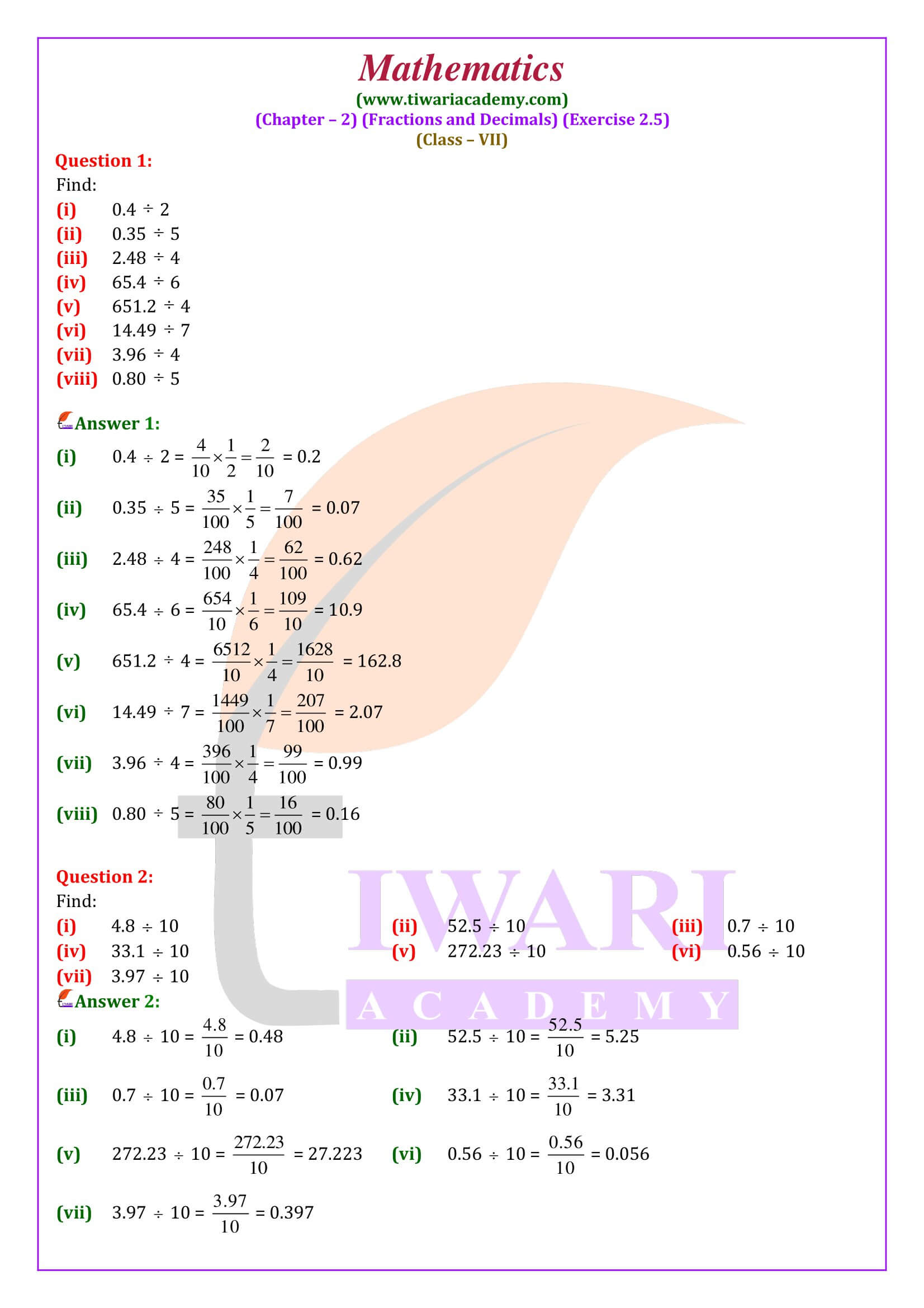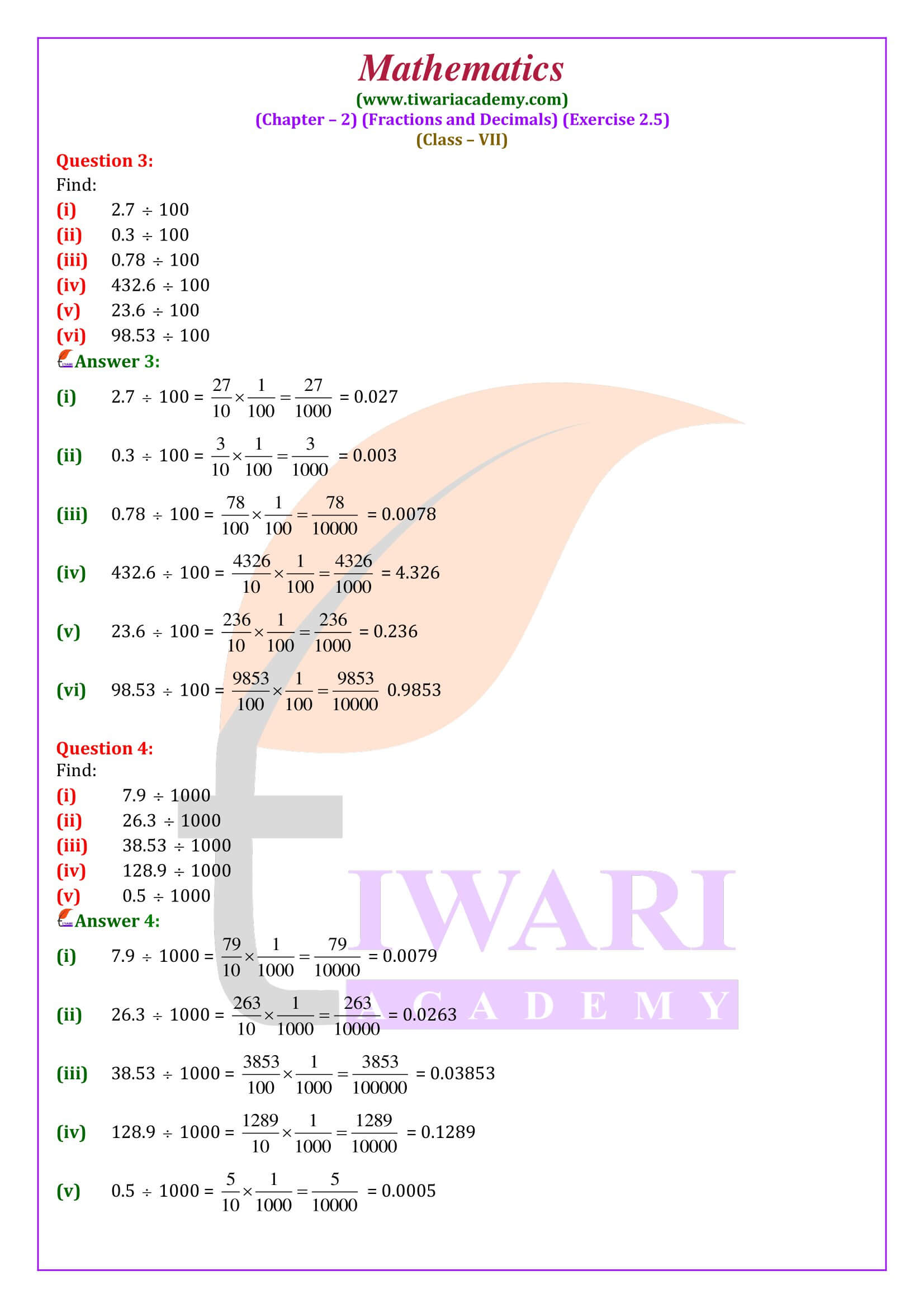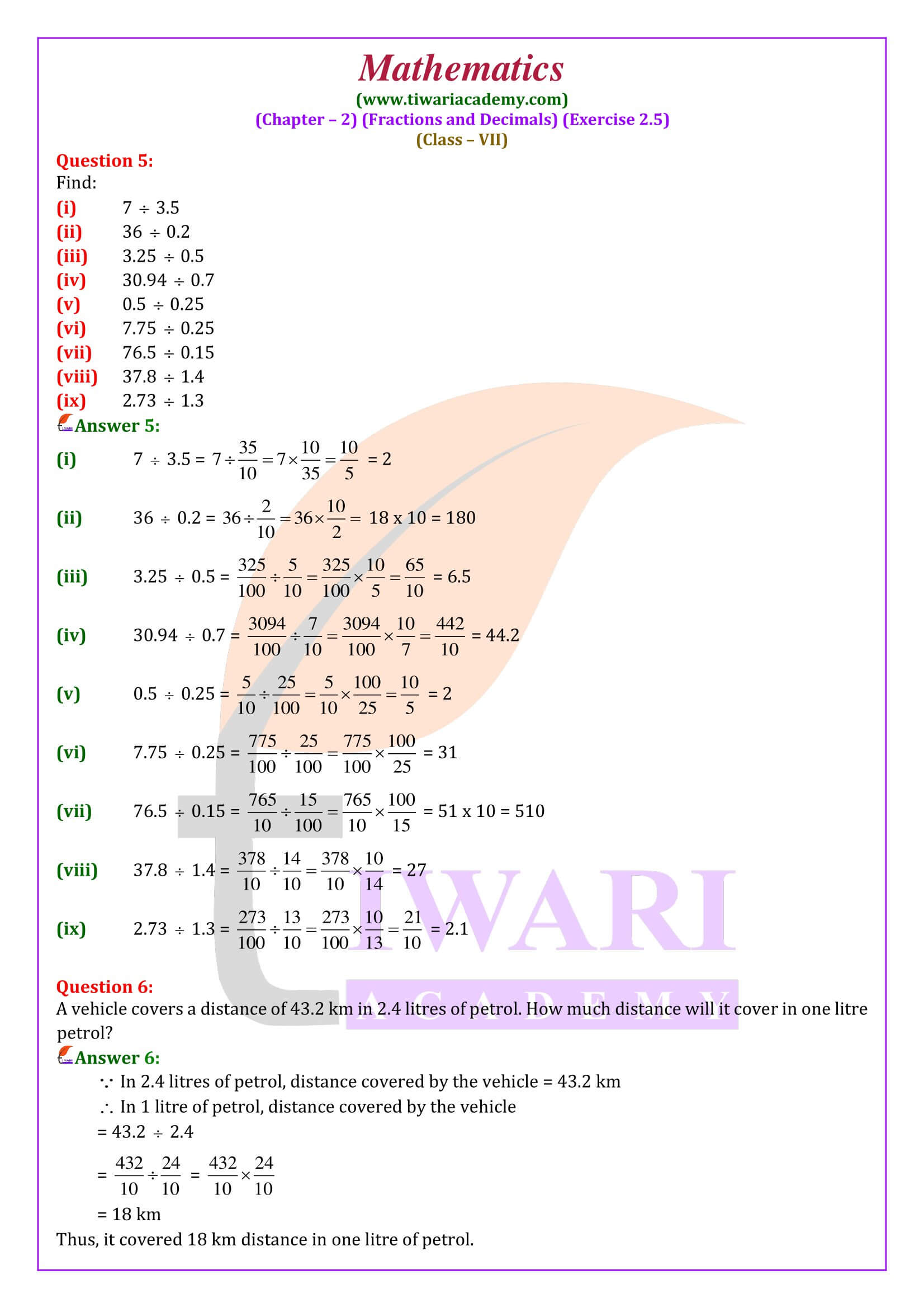NCERT Solutions for Class 7 Maths Chapter 2 Exercise 2.5 Updated for New Session 2025-26, Fractions and Decimals in Hindi and English medium. Students of class 7 can get the revised solutions of ex. 2.5 mathematics based on new textbooks issued for 2025-26 Exams.
NCERT Solutions Class 7 Maths Exercise 2.5 in Hindi and English Medium
| Class: 7 | Mathematics |
| Chapter: 2 | Exercise: 2.5 |
| Topic Name: | Fractions and Decimals |
| Content Mode: | Text, Images and Videos |
| Academic Session: | 2025-26 |
| Medium: | English and Hindi Medium |
Class 7 Maths Chapter 2 Exercise 2.5 Solution
All the question answers are done step by step using easier method, so that students of class 7 understand properly. In class 7 math exercise 2.5 we will learn how the division of decimal number take place. Here we will divide natural numbers as well as decimal numbers from a decimal number.
Class 7 Maths Chapter 2: Multiplication of Decimals
Multiplication of a Decimal by 10, 100, 1000, etc.
Rules: (i) On multiplying a decimal by 10, the decimal point is shifted to the right by one place.
(ii) On multiplying a decimal by 100, the decimal point is shifted to the right by two places.
(iii) On multiplying a decimal by 1000, the decimal point is shifted to the right by three places, and so on.
Class 7 Maths Exercise 2.5 Extra Questions
Find the product: (i) 67.24 x 10 (ii) 4.956 x 100 (iii) 2.3748 x 1000
We have:
(i) 67.24 x 10 = 672.4 [shifting decimal point to the right by 1 place]
(ii) 4.956 x 100 = 495. 6 [shifting decimal point to the right by 2 places]
(iii) 2.3748 x 1000 = 2374.8 [shifting decimal point to the right by 3 places]
Find the product: (i) 5.43 x 15 (ii) 0.327 x 12 (iii) 0.065 x 9
We have:
(i) 543 x 15 = 8145. (2 places of decimal)
So, 5.43 x 15 = 81.45.
(ii) 327 x 12 = 3924. (3 places of decimal)
So, 0.327 x 12 = 3.924.
(iii) 65 x 9 = 585. (3 places of decimal)
So, 0.0645 x 9 = 0.585.
Multiply 73.68 by 5.4
First we multiply 7368 by 54.
7368 x 54
29472
368400
397872
Divide: (i) 16.8 by 10 (ii) 236.4 by 100 (iii) 3709.6 by 1000
We have:
(i) 16.8 ÷ 10 = = 1.68 [shifting decimal point to the left by 1 place]
(ii) 236.4 ÷ 100 = = 2.364 [shifting decimal point to the left by 2 places]
(iii) 3709.6 ÷ 1000 = = 3.7096 [shifting decimal point to the left by 3 places]
Multiplication of a Decimal by a Whole Number
Step 1. Multiple the decimal without the decimal point by the given whole number.
Step 2. Mark the decimal point in the product to have as many places of decimal as are there are in the given decimal.
Class 7 Maths Exercise 2.5 Important Questions
1 kg of milk has 0.264 kg of fat. How much fat in there is 12.5 kg of milk?
Quantity of fat in 1 kg of milk = (0.264 x 12.5) kg
= 3.3000 kg = 3.3 kg
Hence, the quantity of fat in 12.5 kg of milk is 3.3 kg.
What is the trick to multiplying decimals?
Multiply the numbers just as if they were whole numbers.
(i) Line up the numbers on the right – do not align the decimal points.
(ii) Starting on the right, multiply each digit in the top number by each digit in the (iii) bottom number, just as with whole numbers.
(iv) Add the products.
What important facts should you remember in multiplying decimals?
Multiplying decimals is the same as multiplying whole numbers except for the placement of the decimal point in the answer. When you multiply decimals, the decimal point is placed in the product so that the number of decimal places in the product is the sum of the decimal places in the factors.
Where do you move the decimal in multiplication?
To multiply decimals, first multiply as if there is no decimal. Next, count the number of digits after the decimal in each factor. Finally, put the same number of digits behind the decimal in the product.
Multiplication of a Decimal by a Decimal
Step 1. Multiply the two decimals without the decimal point just like whole numbers.
Step 2. Mark the decimal point in the product in such a way that the number of decimal places in the product is equal to the sum of the decimal places in the given decimals.
Class 7 Maths Chapter 2: Division of Decimals
Dividing a Decimal by 10, 100, 1000, etc.
Rules: (i) On dividing a decimal by 10, the decimal point is shifted to the left by one place.
(ii) On dividing a decimal by 100, the decimal point is shifted to the left by two places.
(iii) On dividing a decimal by 1000, the decimal point is shifted to the left by three places, and so on.
Dividing A Decimal by a Whole Number
Step 1. Perform the division by considering the dividend a whole number.
Step 2. When the division of whole-number part of the dividend is complete, put the decimal point in the quotient and proceed with the division as in case of whole numbers.
How many questions and examples are there in exercise 2.5 of class 7th Maths?
In exercise 2.5 of class 7th Maths, there are 6 questions and three examples (examples 9, 10, 11). Short answer type questions like fill in the blanks, true or false (yes or no), one-word answer, MCQ type questions can also come from this exercise. 1 mark and 2 marks questions can be asked from this exercise.
Can students do exercise 2.5 of class 7th Maths in 3 days?
Students can do exercise 2.5 of class 7th Maths in 3 days or not depends on student’s working speed, efficiency, capability, and many other things. But if they try hard to do exercise 2.5 of class 7th Maths in 3 days, they can easily do that.
How is exercise 2.5 of class 7th Maths?
Exercise 2.5 of class 7th Maths is not a very complicated exercise. Some questions of this exercise are simple, and students solve them very rapidly. But, in some questions students face a little issue and need the teacher’s help or parent’s help.
Which questions and examples are the important questions and examples of exercise 2.5 of class 7th Maths?
There are 6 questions and three examples (examples 9, 10, 11) in exercise 2.5 of class 7th Maths. All questions and examples of this exercise are significant for the exams. Any question and example of this exercise can come in the exams.
Which concepts do students learn in exercise 2.5 of class 7th Maths?
The concepts that students learn in exercise 2.5 of class 7th Maths are:
1. Division of Decimal Numbers.
2. Division by 10, 100, and 1000.
3. Division of a Decimal Number by a Whole Number.
4. Division of a Decimal Number by another Decimal Number.







